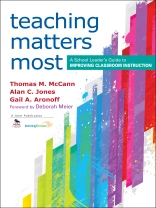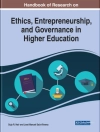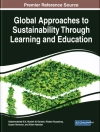A laser-beam focus on improving instruction to improve learning
Saying ‘teaching matters most’ is easy, and seems obvious. Making it the top priority for school leaders and staff is not so easy—in fact, it′s messy. If we want to change how students write, compute, and think, then teachers must change how they teach. They must transform the old ‘assign-and-assess’ model into engaging, compassionate, coherent, and rigorous instruction. The authors show school leaders how to make this happen amidst myriad distractions, initiatives, and interruptions.
Unlike other books that stop at evaluating teachers and instruction, this work demonstrates how to grow schools′ instructional capacities with a three-step process that involves:
The authors provide helpful guidance on issues such as hiring, induction, professional development, mentoring, and teacher evaluation. Each chapter offers specific action steps toward building the blueprint for improvement. Also included are frameworks for completing instructional audits in schools, and probes, instruments, and protocols for measuring and tracking the quality of instruction. Leaders will find excellent guidance for spearheading and sustaining a focused and aligned effort to improve the quality of teaching to impact all learners.
สารบัญ
Foreword by Deborah Meier
Preface: Lessons Learned From Experience
A “New” Take in School Improvement
Central Theme
Organization of the Book
What Makes This Book Distinctive
Acknowledgments
About the Authors
1. What are common practices in schools?
What We Found in Classrooms
Truths Hidden in Plain View
Transforming Accountability
New Direction
Are There “Best Practices” in Teaching?
Bringing Best Practices to Scale
Are Some Practices Better Than Others?
The Poverty of Prescribing Best Practices
2. What distinguishes quality teaching?
Three Classrooms, Three Practitioners
A Simple Truth Hidden in Plain View
Disjointed Teaching
Why Teachers Are Frustrated
What Is Quality Teaching?
Observing High-Quality Teaching
Instructional Systems
The Road Less Traveled
3. How do we learn about the quality of our teaching?
How to Make the Case for an Emphasis on Teacher Quality
Three Leadership Requirements
Defining Quality Teaching
How to Engage School Personnel in Devising a Vision of Quality Instruction
Some Rudiments of Quality Teaching
The Importance of Curriculum Coherence
Learning From Students
The Current State of Teaching in Your School
How to Evaluate the Quality of Teaching in Your School
4. What should induction and mentoring look like?
Basic Components of a Teacher Mentor Program
Facing Critical Junctures Together
Planning for New Teachers’ Success
5. What should professional development look like?
What We Know About Professional Development
The Disregarded Truths of Professional Development
The Components of a Professional Learning Culture
Building Blocks of Professional Learning
Leading Professional Learning Communities
6. How can teacher evaluaiton become more meaningful?
“Drive-By” Teacher Evaluation
“Absentee Landords”
Lists and Rubrics Abound
7. How can we sustain a culture of exceptional instruction?
Ten Actions to Sustain High-Quality Teaching
Systems in Place
Sanctity of the Classroom
Envisioning Quality Teaching
Right People in Right Places
Balanced Leadership
Clear and Timely Communication
Standards for Professional Conduct
Collaboration
Reflection and Continuous Improvement
Ongoing Professional Dialogues
8. How do we face our leadership challenges?
Suppressing Distraction
Building Principal’s Knowledge
Building Trust
Influencing Resistant Teachers
Coping With the Pace
Final Thoughts
Resources
A. How Can You Spot a Really Good Teacher?
B. Framework for Observing Classes
C. Student Forum Questions
D. Teacher Interview Questions
References
Index
เกี่ยวกับผู้แต่ง
Mrs. Gail Aronoff is an educational consultant who worked for 37 years in several schools, both as teacher and administrator. She has worked with students with special needs in elementary, middle school, and high school, and served as a liaison between schools and the families of struggling learners. At the high school level, she taught struggling learners for fourteen years and held the position of Assistant Principal for Student Services for twelve years. She served a highly diverse population with many ESL students as well as those from low income families. She has mentored and supervised teachers and administrators, creating and implementing model programs to address the needs of reluctant learners and those with special needs. Mrs. Aronoff currently serves as a consultant to schools for school improvement and reform.












